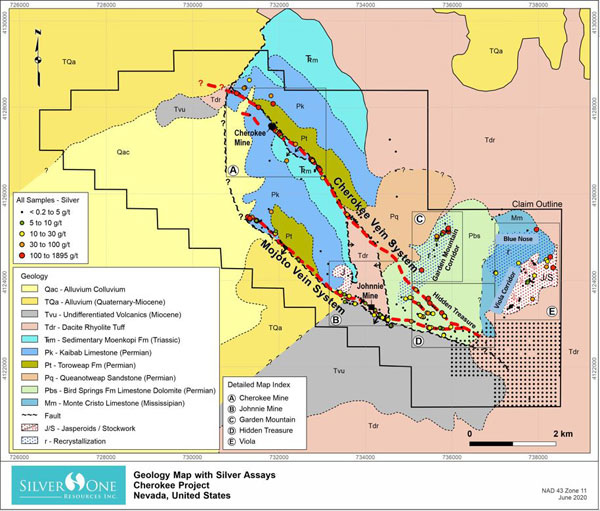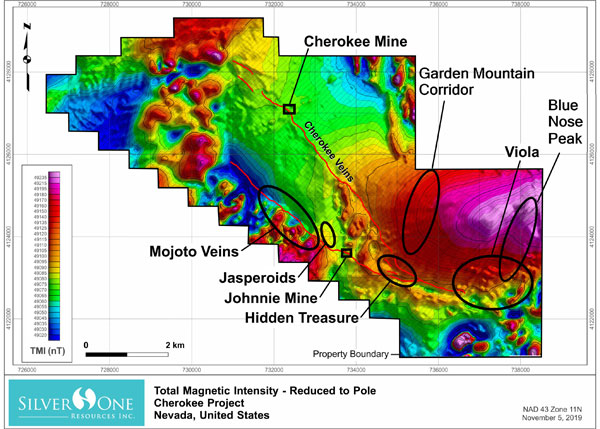Vancouver, British Columbia–(June 10, 2020) – Silver One Resources Inc. (TSXV: SVE) (OTCQB: SLVRF) (FSE: BRK1) (“Silver One” or the “Company”) is pleased to announce results of the 2019-20 mapping, sampling and data compilation campaign at its 100% owned Cherokee high-grade, silver-copper with gold project in Lincoln County, Nevada. Cherokee hosts multiple northwest trending, high-grade, epithermal style precious and base metal bearing vein systems that have been identified along the length of two known structural corridors. These mineralized systems have been traced for over 12 km along strike.
Several newly discovered areas with high-grade select surface rock samples have been identified outside the previously sampled Cherokee – Hidden Treasure and Mojoto – Johnnie vein systems (see maps below and July 9 and 19, 2018; October 23, 2018; September 3, 2019 and November 11, 2019 news releases). Some of these new areas include Garden Mountain, Viola, and Blue Nose in the southeastern portion of the property, marginal to an interpreted buried intrusive complex. The location of this interpreted intrusive is marked by a pronounced magnetic high signature identified in an airborne magnetometer survey completed by Silver One in 2019 (see Figure 2 below and Company News Release of November 11, 2019). Additional maps showing more detailed sampling results are also available on the Company’s website at www.silverone.com.
Highlights Include:
- Recent sampling has returned strong silver, gold and elevated copper, lead, zinc values from newly identified zones. Select surface samples collected in the Garden Mountain area have yielded results ranging from background levels to 418 g/t silver, 0.03 g/t gold and 1.05% and copper, while the Viola – Blue Nose areas have returned values from background to 647 g/t silver, 0.03 g/t gold and 2.47% copper and 253 g/t silver, 2.05 g/t gold and 0.72% copper. Lead and zinc values vary from background to 9.3% and 39% respectively. (see maps on www.silverone.com).
- Cherokee, Mojoto and Hidden Treasure veins are covered by alluvium and post mineral volcanic rocks to the northwest, and overlain by pre and post mineral volcanics to the southeast. Soil geochemistry, and magnetometry however, indicate that the veins may continue under the cover in both strike directions.
- Previous sampling completed in 2018 highlighted strong silver and copper values at the historic Cherokee Mine workings and strong silver and gold values at Hidden Treasure (see Company news releases of July 9 and 19, 2018; October 23, 2018; September 3, 2019 and November 11, 2019 and maps on www.silverone.com).
- Cherokee veins occur within the same aged limestones as those that host high-grade silver and gold veins as well as copper-lead-zinc-silver-gold limestone replacement deposits historically mined at the Pioche mining camp, located approximately 70 km north of Cherokee.
Mineralization identified at Cherokee to date can best be described as epithermal in nature, a geological system associated with many of the silver and gold precious metal deposits and mines in Nevada and around the world. Regionally, the area also hosts previously producing, large tonnage limestone replacement styles of mineralization (Pioche historic mining camp). A third type of mineralization may also be present at Cherokee. Past exploration by third parties at the southern margin of the Cherokee claims was targeting a porphyry molybdenum deposit associated with an interpreted buried intrusive. This intrusive is represented by the strong magnetic high seen on the Company’s recent airborne magnetometer survey (see map below).
Greg Crowe, President and CEO commented: “The most intriguing aspect about Cherokee is the increasing number of new mineralized discoveries along with our evolving understanding of the various styles of mineralization hosted within the property. Every field season yields additional targets and continues expanding the upside potential of this already robust silver-gold-copper prospect. In addition to the large, high-grade epithermal veins, such as those sampled at Cherokee, Hidden Treasure, Johnnie and Mojoto, we are also seeing more elements indicative of intrusive-centered systems around the newly discovered Garden Mountain and the Viola – Blue Nose areas. This means that in addition to the significant high-grade epithermal vein mineralization exposed on surface, the project could also host skarn and limestone replacement polymetallic mineralization rich in gold and silver, similar to carbonate replacement mineralization occurring at Pioche to the north of Cherokee, or to some of the large Mexican producers such as Santa Eulalia, Chihuahua and Mapimi-Ojuela and Velardeña, Durango. Additionally, drilling in the 1980’s in the southeasternmost part of Cherokee targeted deeply buried porphyry molybdenum mineralization. The amount and wide distribution of high-grade vein samples exposed on surface, in combination with the multi-faceted styles of other potential mineralized systems, make Cherokee a very highly prospective silver, gold and base metal property.”
With the recent field work, approximately 70% of the exposed area of the property has been mapped at various levels of detail and preliminarily sampled. In-fill sampling was also conducted in areas previously mapped. As a result, several new targets have been identified, three of which have been partially mapped and sampled. Preliminary drilling targets at some of the high-grade areas have been selected. However, assay results in larger areas of hydrothermal alteration reveal that several targets remain open and will require additional in-fill mapping and sampling. Further work to better outline and rank additional drilling targets is highly warranted.
Work Detail
The 2019-20 campaign consisted of reconnaissance or detailed mapping of various area, as well as limited systematic rock sampling, reconnaissance rock sampling, and systematic soil sampling in the southeastern end of the property. Nearly 70% of the outcropping area has been mapped at either reconnaissance and/or detail level. Approximately 50% of the property is covered by alluvium or postmineral rocks, which impedes direct observation yet covers potential extensions of mineralization, particularly northwest and southeast of the main 12 km plus-NW-SE structural corridor that hosts the Cherokee, Mojoto, Johnnie and Hidden Treasure vein systems.
A total of 1,137 samples have been collected and assayed to date, including 91 quality control (QA/QC) blanks and standards. 544 samples are rock samples, the majority of which (85%) consist of chip samples up to 5 meters wide (average 1.4 meters). Approximately 15% of the rock samples are dump, grab or float samples.
A total of 525 soil samples have been collected from a systematic grid in the southeastern part of the property along the potential extension of the Hidden Treasure veins (Figure 1 below). Significant soil anomalies of gold (13-53ppb), As (35-231) and Mo (3-25 ppm) at the intersection of the Hidden Treasure and Viola systems suggest that the Hidden Treasure vein system may continue for at least 700 farther to the southeast.
The main targets on the property are the high-grade gold-silver epithermal veins. However, another significant feature in this property consists of potential intrusive centered mineralization at the Viola and Blue Nose areas (Figures 1 and 2 below). Numerous jasperoids, gossans and solution breccias filled with copper and base metal oxides of the Viola, Blue Nose Peak and Garden Mountain areas occur peripheral and centered around an interpreted large ellipsoidal intrusive body buried at depth in the southeastern part of the property. The veins, breccias and jasperiods may be a distal manifestation of potentially large skarns or replacement zones proximal to the limestone-intrusive contact. Preliminary mapping conducted at the Garden Mountain, Blue Nose and Viola areas reveals scores of pits with pockets of silver-copper oxide mineralization from centimeters to a few meters thick and up to tens of meters long developed in favorable limestone horizons, especially near the contact between limestones and overlaying volcanic rocks. Additionally, ample zones of hydrothermal alteration, including structures hosting altered felsic dykes and locally quartz veining, occur along two northeast oriented corridors, i.e. the Viola and Garden Mountain corridors as can be seen with the magnetometry and structures mapped in the field (see Figures below).
Both the extensive distribution of high-grade veins sampled over 12 km strike, along with the numerous styles of alteration and mineralization, make Cherokee a very highly prospective exploration target.
Quality Assurance/Quality Control
The samples were hand-delivered by Silver One personnel to the labs to ensure proper chain-of-custody procedures. The samples were assayed by American Assay Laboratories (ISO/IEC 17025:2005) located in Reno, Nevada. The QA/QC program included the submission of Certified Reference Materials, blanks, and duplicates at random intervals. Certified Standards and blanks were inserted at a rate of one standard and blank for every 20 samples (5% of total). At the laboratory, the samples were dried, split and assayed. The samples were then analyzed for total gold by fire assay with an AA finish, silver and multi-elements by aqua regia digestion-multi-element ICP-ES. Over limits of silver and gold were further analyzed by fire assay-gravimetric using a 30-gram sample. Over limits of copper, lead and zinc were analyzed by AAS with aqua regia digestion. As part of the standard operating procedures, the lab also inserted certified blanks, standards and includes duplicate analyses.
Fig 1. Geology map of the Cherokee project showing areas mentioned in the text, selected alteration areas, and silver values of rock samples collected to date. The black dots in the southeast corner represent the grid of soil samples collected.

Fig 2, TMI-RTP Total magnetic intensity, reduced to the pole map.

Qualified Person
The technical content of this news release has been reviewed and approved by Greg Crowe, P. Geo, President and CEO of Silver One, and a Qualified Person as defined by National Instrument 43-101.
About Silver One
Silver One is focused on the exploration and development of quality silver projects. The Company holds an option to acquire a 100%-interest in its flagship project, the past-producing Candelaria Silver Mine, Nevada. Potential reprocessing of silver from the historic leach pads at Candelaria is being investigated. Additional opportunities lie in previously identified high-grade silver intercepts down-dip and the possibility of increasing the substantive silver mineralization along-strike from the two past-producing open pits.
The Company has staked 636 lode claims and entered into a Lease/Purchase Agreement to acquire five patented claims on its Cherokee project located in Lincoln County, Nevada, host to multiple silver-copper-gold vein systems traced to date for over 12 km along-strike. The property also has potential for limestone related polymetallic plus silver and gold and/or other intrusive related systems at depth.
Silver One holds an option to acquire a 100% interest in the Silver Phoenix Project. The Silver Phoenix Project is a very high-grade native silver prospect that lies within the “Arizona Silver Belt”, immediately adjacent to the prolific copper producing area of Globe, Arizona.
In addition, the Company also holds a 100% interest in three significant silver assets located in Mexico – Peñasco Quemado, Sonora; La Frazada, Nayarit; and Pluton, Durango, acquired from First Mining Gold, one of the Company’s largest shareholders.
For more information, please contact:
Silver One Resources Inc.
Gary Lindsey
Phone: (720) 273-6224
Email: [email protected]
Forward-Looking Statements
Information set forth in this news release contains forward-looking statements that are based on assumptions as of the date of this news release. These statements reflect management’s current estimates, beliefs, intentions, and expectations. They are no guarantees of future performance. Silver One cautions that all forward-looking statements are inherently uncertain, and that actual performance may be affected by a number of material factors, many of which are beyond Silver One’s control. Such factors include, among other things: risks and uncertainties relating to Silver One’s limited operating history, ability to obtain sufficient financing to carry out its exploration and development objectives on its mineral properties, obtaining the necessary permits to carry out its activities and the need to comply with environmental and governmental regulations. Accordingly, actual, and future events, conditions and results may differ materially from the estimates, beliefs, intentions and expectations expressed or implied in the forward-looking information. Except as required under applicable securities legislation, Silver One undertakes no obligation to publicly update or revise forward-looking information.
NEITHER TSX VENTURE EXCHANGE NOR ITS REGULATION SERVICES PROVIDER (AS THAT TERM IS DEFINED IN THE POLICIES OF THE TSX VENTURE EXCHANGE) ACCEPTS RESPONSIBILITYFOR THE ADEQUACY OR ACCURACYOF THIS RELEASE.
Original Article: https://www.silverone.com/news/2020/silver-one-identifies-additional-targets-through-mapping-and-sampling-at-its-cherokee-project-nevada/





















